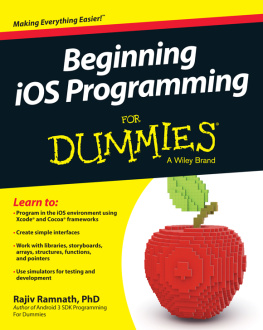Walter Quesada and Bob Lautenbach - Programming Voice Interfaces
Here you can read online Walter Quesada and Bob Lautenbach - Programming Voice Interfaces full text of the book (entire story) in english for free. Download pdf and epub, get meaning, cover and reviews about this ebook. year: 2017, publisher: OReilly Media, Inc., genre: Home and family. Description of the work, (preface) as well as reviews are available. Best literature library LitArk.com created for fans of good reading and offers a wide selection of genres:
Romance novel
Science fiction
Adventure
Detective
Science
History
Home and family
Prose
Art
Politics
Computer
Non-fiction
Religion
Business
Children
Humor
Choose a favorite category and find really read worthwhile books. Enjoy immersion in the world of imagination, feel the emotions of the characters or learn something new for yourself, make an fascinating discovery.
- Book:Programming Voice Interfaces
- Author:
- Publisher:OReilly Media, Inc.
- Genre:
- Year:2017
- Rating:3 / 5
- Favourites:Add to favourites
- Your mark:
- 60
- 1
- 2
- 3
- 4
- 5
Programming Voice Interfaces: summary, description and annotation
We offer to read an annotation, description, summary or preface (depends on what the author of the book "Programming Voice Interfaces" wrote himself). If you haven't found the necessary information about the book — write in the comments, we will try to find it.
Programming Voice Interfaces — read online for free the complete book (whole text) full work
Below is the text of the book, divided by pages. System saving the place of the last page read, allows you to conveniently read the book "Programming Voice Interfaces" online for free, without having to search again every time where you left off. Put a bookmark, and you can go to the page where you finished reading at any time.
Font size:
Interval:
Bookmark:
by Walter Quesada and Bob Lautenbach
Copyright 2018 Walter Quesada, Bob Lautenbach. All rights reserved.
Printed in the United States of America.
Published by OReilly Media, Inc. , 1005 Gravenstein Highway North, Sebastopol, CA 95472.
OReilly books may be purchased for educational, business, or sales promotional use. Online editions are also available for most titles (http://oreilly.com/safari). For more information, contact our corporate/institutional sales department: 800-998-9938 or corporate@oreilly.com .
- Editors: Susan Conant and Jeff Bleiel
- Production Editor: Shiny Kalapurakkel
- Copyeditor: Jasmine Kwityn
- Proofreader: Kim Cofer
- Indexer: Angela Howard
- Interior Designer: David Futato
- Cover Designer: Karen Montgomery
- Illustrator: Rebecca Demarest
- October 2017: First Edition
- 2017-10-04: First Release
See http://oreilly.com/catalog/errata.csp?isbn=9781491956069 for release details.
The OReilly logo is a registered trademark of OReilly Media, Inc. Programming Voice Interfaces, the cover image, and related trade dress are trademarks of OReilly Media, Inc.
While the publisher and the authors have used good faith efforts to ensure that the information and instructions contained in this work are accurate, the publisher and the authors disclaim all responsibility for errors or omissions, including without limitation responsibility for damages resulting from the use of or reliance on this work. Use of the information and instructions contained in this work is at your own risk. If any code samples or other technology this work contains or describes is subject to open source licenses or the intellectual property rights of others, it is your responsibility to ensure that your use thereof complies with such licenses and/or rights.
978-1-491-95600-7
[LSI]
As its title implies, this book focuses on programming voice interfaces for connected devices. We wanted to share what weve learned from experimenting with some of the various platforms currently available, such as Amazon Alexa, API.AI, and others. We also tried to condense the choices to some of the main players and provide step-by-step, how-to examples, allowing you to dig in quickly and start playing. Our goal was to create a reference guide to voice interfaces in under 200 pages. Some of the topics in this book could very well have entire books dedicated to them. We obviously had to make hard choices on what to include and exclude, so we focused on trying to expose you to whats possible; to pique your curiosity to dig deeper and continue experimenting on your own.
We assume you have some experience programming with Node.js and/or C#, but you can still work through all of the examples even if you are a relative newbie to coding .
Voice interfaces are here to stay and will only get more intelligent and human-like as time and technology march forward. We hope this book encourages you to be part of this new and exciting platform. We look forward to reading about you in the future and all of the incredible experiences youve created using voice-based technologies.
There are only two main requirements for readers of this book. The first requirement is some level of experience programming in either Python, C#, or Node.js. Second, simply a desire to learn. We wrote this book for all the makers out therethose who live to learn and experiment, and who love to tinker and find technology-based solutions for everyday problems.
The following typographical conventions are used in this book:
ItalicIndicates new terms, URLs, email addresses, filenames, and file extensions.
Constant widthUsed for program listings, as well as within paragraphs to refer to program elements such as variable or function names, databases, data types, environment variables, statements, and keywords.
Constant width boldShows commands or other text that should be typed literally by the user.
Constant width italicShows text that should be replaced with user-supplied values or by values determined by context.
This element signifies a tip or suggestion.
This element signifies a general note.
This element indicates a warning or caution.
Safari (formerly Safari Books Online) is a membership-based training and reference platform for enterprise, government, educators, and individuals.
Members have access to thousands of books, training videos, Learning Paths, interactive tutorials, and curated playlists from over 250 publishers, including OReilly Media, Harvard Business Review, Prentice Hall Professional, Addison-Wesley Professional, Microsoft Press, Sams, Que, Peachpit Press, Adobe, Focal Press, Cisco Press, John Wiley & Sons, Syngress, Morgan Kaufmann, IBM Redbooks, Packt, Adobe Press, FT Press, Apress, Manning, New Riders, McGraw-Hill, Jones & Bartlett, and Course Technology, among others.
For more information, please visit http://oreilly.com/safari.
Please address comments and questions concerning this book to the publisher:
- OReilly Media, Inc.
- 1005 Gravenstein Highway North
- Sebastopol, CA 95472
- 800-998-9938 (in the United States or Canada)
- 707-829-0515 (international or local)
- 707-829-0104 (fax)
To comment or ask technical questions about this book, send email to .
For more information about our books, courses, conferences, and news, see our website at http://www.oreilly.com.
Find us on Facebook: http://facebook.com/oreilly
Follow us on Twitter: http://twitter.com/oreillymedia
Watch us on YouTube: http://www.youtube.com/oreillymedia
Special thanks to Walter for inviting me to participate in this book. It was a fun ride, my friend! I would also like to thank those who have mentored and supported me along the way. Without their support and encouragement I would not be where I am today. I cant possibly name them all, but would like to give a shout out to my friend and coauthor Walter, from whom I have learned so much, my favorite tech evangelist, David Isbitski, and finally, Bart Butler, who has helped me in more ways than I can mention.
Thanks to our editor Jeff Bleielhis patience and guidance throughout this process was invaluable.
Finally, I want to thank and dedicate this book to my wife, Vivian, and my two incredible boys, Steven and Tyler. Your patience and support energize and motivate me every day.
I would like to thank David Noderer for connecting me with Susan Conant at OReilly. Thank you both for helping kick off this amazing journey. Thanks to my coauthor in crime, Bob, for saving my ass and helping take the book to the finish line. A special thanks to our editor, Jeff Bleiel, whose patience with my slacker procrastinating ways continues to be extremely appreciated.
I would also like to thank Cathy Pearl and Chris Maury, whose constructive and valuable feedback on the book helped us elevate the content further.
Additionally, I would like to thank those whose advice and mentorship throughout the years were critical in shaping my career and role as a technologist. Some of those awesome folks include David Clarke, Chris Curran, Dan Eckert, and David Isbitski. There are too many to name here so for those unmentioned, you know who you are and know that my thanks goes out to you as well.
Font size:
Interval:
Bookmark:
Similar books «Programming Voice Interfaces»
Look at similar books to Programming Voice Interfaces. We have selected literature similar in name and meaning in the hope of providing readers with more options to find new, interesting, not yet read works.
Discussion, reviews of the book Programming Voice Interfaces and just readers' own opinions. Leave your comments, write what you think about the work, its meaning or the main characters. Specify what exactly you liked and what you didn't like, and why you think so.









